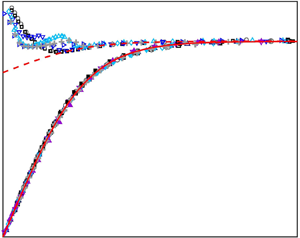Article contents
Thermal boundary-layer structure in laminar horizontal convection
Published online by Cambridge University Press: 31 March 2021
Abstract

We present experimentally obtained time-averaged vertical temperature profiles  $\theta (z)$ in horizontal convection (HC) in water (Prandtl number
$\theta (z)$ in horizontal convection (HC) in water (Prandtl number  $Pr \simeq 6$), which were measured near the heating and cooling plates that are embedded in the bottom of HC samples. Three HC rectangular samples of different sizes but the same aspect ratio
$Pr \simeq 6$), which were measured near the heating and cooling plates that are embedded in the bottom of HC samples. Three HC rectangular samples of different sizes but the same aspect ratio  $\varGamma \equiv L:W:H = 10:1:1$ (
$\varGamma \equiv L:W:H = 10:1:1$ ( $L$,
$L$,  $W$ and
$W$ and  $H$ are the length, width and height of the sample, respectively) were used in the experiments, which allowed us to study HC in a Rayleigh-number range
$H$ are the length, width and height of the sample, respectively) were used in the experiments, which allowed us to study HC in a Rayleigh-number range  $2 \times 10^{10} \lesssim {Ra} \lesssim 9 \times 10^{12}$. The measurements revealed that above the cooling plate, the mean temperature profiles have a universal scaling form
$2 \times 10^{10} \lesssim {Ra} \lesssim 9 \times 10^{12}$. The measurements revealed that above the cooling plate, the mean temperature profiles have a universal scaling form  $\theta (z/\lambda _c)$ with
$\theta (z/\lambda _c)$ with  $\lambda _c$ being a
$\lambda _c$ being a  $Ra$-dependent thickness of the cold thermal boundary layer (BL). The
$Ra$-dependent thickness of the cold thermal boundary layer (BL). The  $\theta (z/\lambda _c)$-profiles agree well with solutions to a laminar BL equation in HC, which is derived under assumption that the large-scale horizontal velocity achieves its maximum near the plate and vanishes in the bulk. Above the heating plate, the mean temperature field has a double-layer structure: in the lower layer, the
$\theta (z/\lambda _c)$-profiles agree well with solutions to a laminar BL equation in HC, which is derived under assumption that the large-scale horizontal velocity achieves its maximum near the plate and vanishes in the bulk. Above the heating plate, the mean temperature field has a double-layer structure: in the lower layer, the  $\theta$ profiles scale with the hot thermal BL thickness
$\theta$ profiles scale with the hot thermal BL thickness  $\lambda _h$, while in the upper layer, they again scale with
$\lambda _h$, while in the upper layer, they again scale with  $\lambda _c$. Both scaling forms are in good agreement with the solutions to the BL equation with a proper parameter choice.
$\lambda _c$. Both scaling forms are in good agreement with the solutions to the BL equation with a proper parameter choice.
JFM classification
Information
- Type
- JFM Rapids
- Information
- Copyright
- © The Author(s), 2021. Published by Cambridge University Press
References
REFERENCES
- 7
- Cited by


